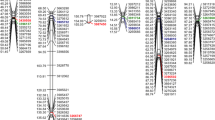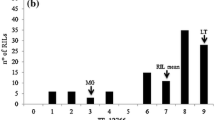Abstract
Stripe rust, leaf rust, and Barley Yellow Dwarf Virus (BYDV) are important diseases of barley (Hordeum vulgare L). Using 94 doubled-haploid lines (DH) from the cross of Shyri x Galena, multiple disease phenotype datasets, and a 99-marker linkage map, we determined the number, genome location, and effects of genes conferring resistance to these diseases. We also mapped Resistance Gene Analog Polymorphism (RGAP) loci, based on degenerate motifs of cloned disease resistance genes, in the same population. Leaf rust resistance was determined by a single gene on chromosome 1 (7H). QTLs on chromosomes 2 (2H), 3 (3H), 5 (1H), and 6 (6H) were the principal determinants of resistance to stripe rust. Two- locus QTL interactions were significant determinants of resistance to this disease. Resistance to the MAV and PAV serotypes of BYDV was determined by coincident QTLs on chromosomes 1 (7H), 4 (4H), and 5 (1H). QTL interactions were not significant for BYDV resistance. The associations of molecular markers with qualitative and quantitative disease resistance loci will be a useful information for marker-assisted selection.
Similar content being viewed by others
Author information
Authors and Affiliations
Additional information
Received: 2 February 1999 / Accepted: 30 December 1999
Rights and permissions
About this article
Cite this article
Toojinda, T., Broers, L., Chen, X. et al. Mapping quantitative and qualitative disease resistance genes in a doubled haploid population of barley (Hordeum vulgare). Theor Appl Genet 101, 580–589 (2000). https://doi.org/10.1007/s001220051519
Issue Date:
DOI: https://doi.org/10.1007/s001220051519




